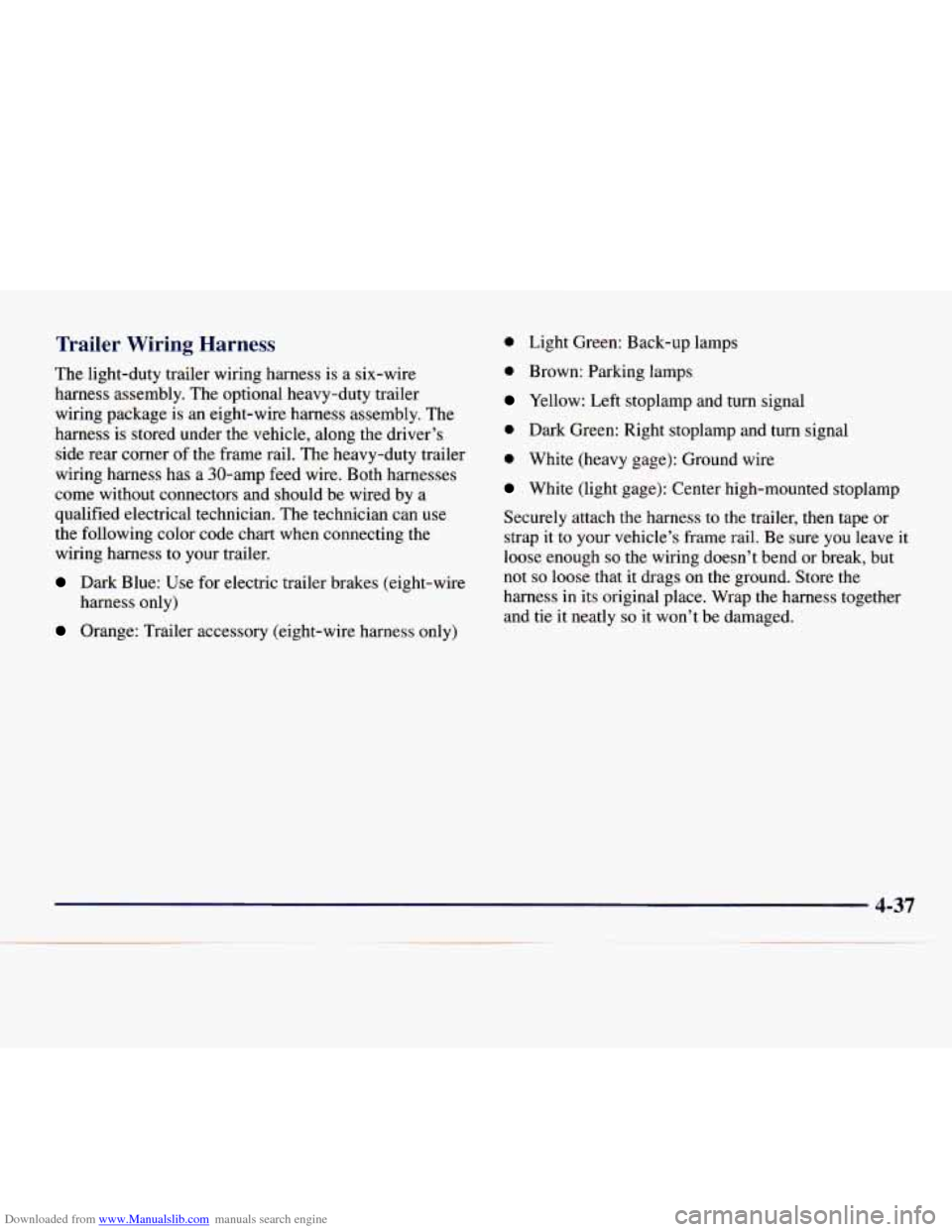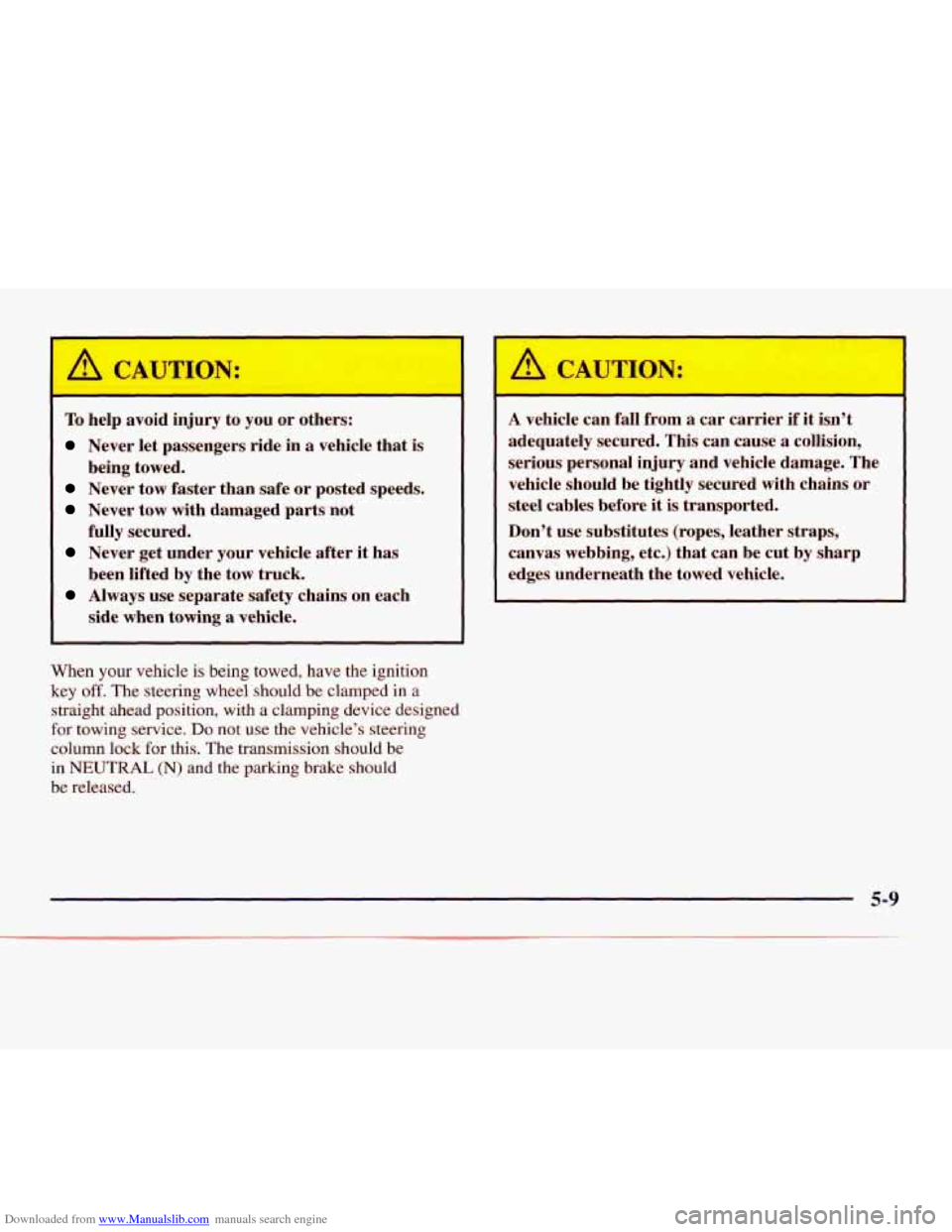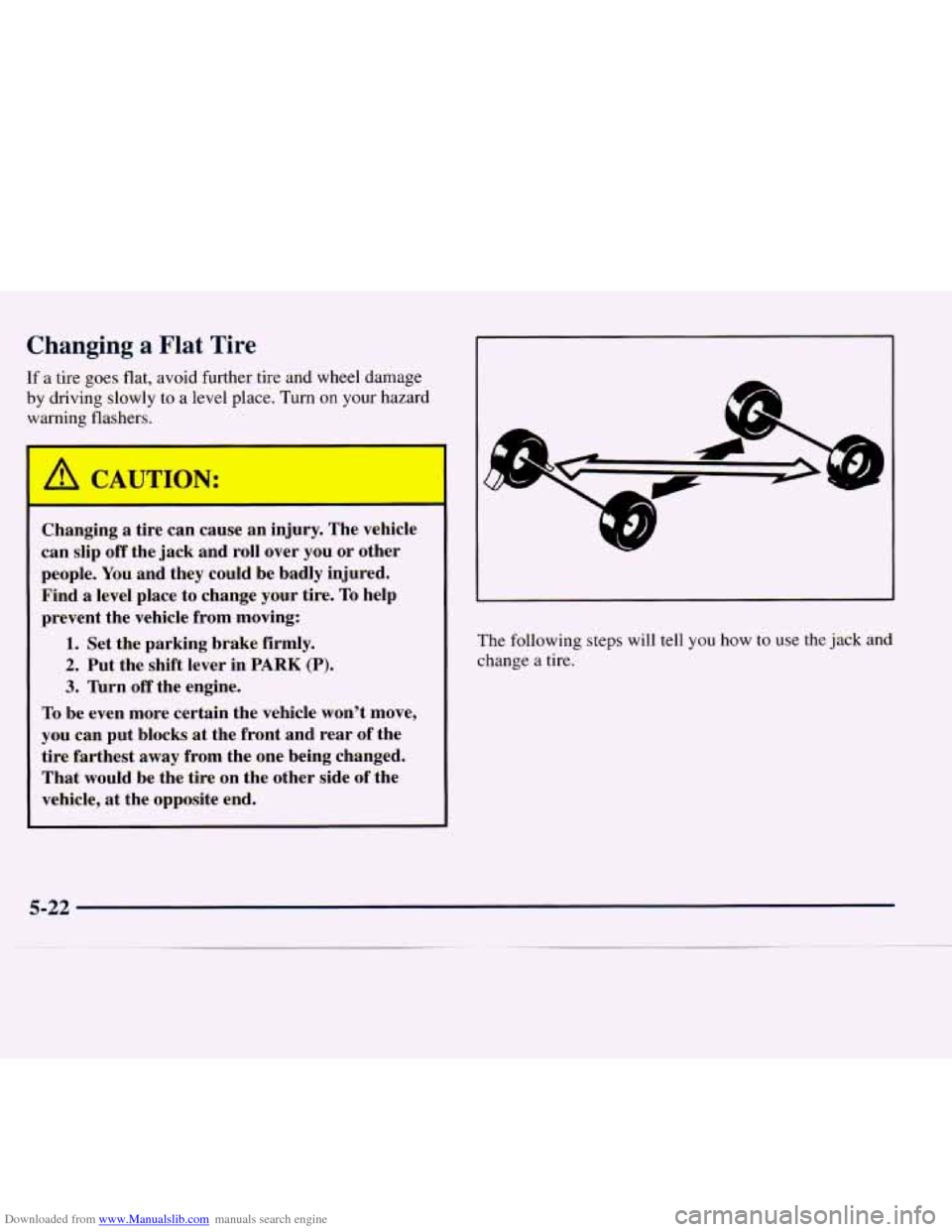1998 CHEVROLET EXPRESS parking brake
[x] Cancel search: parking brakePage 199 of 386

Downloaded from www.Manualslib.com manuals search engine Parking on Hills
You really should not park your vehicle, with a trailer
attached, on a hill. If something goes wrong, your
rig
could start to move. People can be injured, and both
your vehicle and the trailer can be damaged.
But
if you ever have to park your rig on a hill, here’s
how to do it:
1.
2.
3.
4.
5.
Apply your regular brakes, but don’t shift into
PARK (P) yet. Then turn your wheels into the curb if
facing downhill or into traffic if facing uphill.
Have someone place chocks under the trailer wheels.
When the wheel chocks are in place, release the
regular brakes
until the chocks absorb the load.
Reapply the regular brakes. Then apply your parking
brake and then shift to PARK
(P).
Release the regular brakes.
When You Are Ready to Leave After
Parking
on a Hill
1. Apply your regular brakes and hold the pedal down
while you:
Start your engine;
Shift into a gear; and
0 Release the parking brake.
2. Let up on the brake pedal.
3. Drive slowly until the trailer is clear of the chocks.
4. Stop and have someone pick up and store the chocks.
Maintenance When Trailer Towing
Your vehicle will need service more often when you’re
pulling a trailer. See the Maintenance Schedule for more
on this. Things that are especially important in trailer
operation are automatic transmission fluid (don’t
overfill), engine oil, axle lubricant, belt, cooling system
and brake adjustment. Each of these is covered in this
manual, and
the Index will help you find them quickly.
If you’re trailering, it’s a good idea to review these
sections before you start your trip.
Check periodically to see that all hitch
nuts and bolts
are tight.
4-36
Page 200 of 386

Downloaded from www.Manualslib.com manuals search engine Trailer Wiring Harness
The light-duty trailer wiring harness is a six-wire
harness assembly. The optional heavy-duty trailer
wiring package is an eight-wire harness assembly. The
harness is stored under the vehicle, along the driver’s
side rear corner of the frame rail. The heavy-duty trailer
wiring harness has a 30-amp feed wire. Both harnesses
come without connectors and should be wired by a
qualified electrical technician. The technician can use
the following color code chart when connecting the
wiring harness to your trailer.
Dark Blue: Use for electric trailer brakes (eight-wire
harness only)
Orange: Trailer accessory (eight-wire harness only)
0 Light Green: Back-up lamps
0 Brown: Parking lamps
Yellow: Left stoplamp and turn signal
0 Dark Green: Right stoplamp and turn signal
0 White (heavy gage): Ground wire
White (light gage): Center high-mounted stoplamp
Securely attach the harness to the trailer, then tape or
strap
it to your vehicle’s frame rail. Be sure you leave it
loose enough
so the wiring doesn’t bend or break, but
not
so loose that it drags on the ground. Store the
harness in its original place. Wrap the harness together
and tie it neatly
so it won’t be damaged.
Page 205 of 386

Downloaded from www.Manualslib.com manuals search engine If you have a diesel engine vehicle with two batteries
(or more)
you should know before you begin that,
especially in cold weather, you may not be able to
get enough power from a single battery in another
vehicle to start your diesel engine.
If your vehicle has more than one battery, use the
battery that
is under the hood of the vehicle - this
will reduce the electrical resistance.
2. Get the vehicles close enough so the jumper cables
can reach, but be sure the vehicles aren’t touching
each other.
U they are, it could cause a ground
connection you don’t want. You wouldn’t be able to
start your vehicle, and the bad grounding could
damage
the electrical systems.
To avoid the possibility of the vehicles rolling, set
the parking brake firmly on both vehicles involved in
the jump start procedure. Put your automatic
transmission in
PARK (P).
3. Turn off the ignition on both vehicles. Turn off all
lamps that
aren’t needed, and radios. This will avoid
sparks and help save both batteries, and could save
your radio.
NOTICE:
If you leave your radio on, it could be badly
damaged. The repairs would not be covered
by
your warranty.
4. Open the hoods and locate the batteries. Find the
positive
(+) and negative (-) terminals on each battery.
’ A CAUTION:
An electric fan can start up even when the engine
is not running and can injure you. Keep hands,
clothing and tools away
from any underhood
electric fan.
5-4
Page 210 of 386

Downloaded from www.Manualslib.com manuals search engine A CAUTWN:
To help avoid injury to you or others:
Never let passengers ride in a vehicle that is
Never tow faster than safe or posted speeds.
Never tow with damaged parts not
Never get under your vehicle after it has
Always use separate safety chains on each
being
towed.
fully secured. been lifted by the tow truck.
side when towing
a vehicle.
When your vehicle is being towed, have the ignition
key
off. The steering wheel should be clamped in a
straight ahead position, with a clamping device designed
for towing service.
Do not use the vehicle’s steering
column lock for this. The transmission should be
in
NEUTRAL (N) and the parking brake should
be released.
I
A vehicle can fall from a car carrier if it isn’t
adequately secured. This can cause
a collision,
serious personal injury and vehicle damage. The
vehicle should be tightly secured with chains or
steel cables before
it is transported.
Don’t use substitutes (ropes, leather straps,
canvas webbing, etc.) that can be cut by sharp
edges underneath the towed vehicle.
5-9
Page 223 of 386

Downloaded from www.Manualslib.com manuals search engine Changing a Flat Tire
If a tire goes flat, avoid further tire and wheel damage
by driving slowly to a level place. Turn on your hazard
warning flashers.
- -
Changing a tire can cause an injury. The vehicle
can slip
off the jack and roll over you or other
people. You and they could be badly injured.
Find a level place to change your tire.
To help
prevent the vehicle from moving:
1. Set the parking brake firmly.
2. Put the shift lever in PARK (P).
3. Xhrn off the engine.
To be even more certain the vehicle won't move,
you can put blocks at the front and rear of the
tire farthest
away from the one being changed.
That would be the tire on the other side of the
vehicle, at the opposite end. The following
steps will tell you how
to use the jack and
change
a tire.
5-22
Page 258 of 386

Downloaded from www.Manualslib.com manuals search engine Checking Transmission Fluid Cold
A cold check is made after the vehicle has been sitting
for eight hours or more with the engine off and is used
only
as a reference. Let the engine run at idle for five
minutes if outside temperatures are
50°F ( 10°C) or
more. If it's colder than
50°F (lO"C), you may have
to idle the engine longer. Should the fluid level be low
during a cold check, you
must perform a hot check
before adding fluid. This will give you a more
accurate reading
of the fluid level.
Checking the Fluid Hot or Cold
0
0
0
0
Park your vehicle on a level place. Keep the engine
running.
With the parking brake applied, place the shift lever
in PARK (P).
With your foot on the brake pedal, move the shift
lever through each gear range, pausing for about
three seconds in each range. Then, position the
shift lever in PARK
(P).
Let the engine run at idle for three minutes or more. Then, without shutting
off the engine, follow these steps:
,., I
1. The
transmission dipstick has a red handle and is
located near the center
of the engine compartment.
Flip
the handle up and then pull out the dipstick
and wipe it with a clean rag or paper towel.
2. Push it back in all the way, wait three seconds and
then pull it back out again.
Page 351 of 386

Downloaded from www.Manualslib.com manuals search engine Starter Switch Check Brake-Transmission Shift Interlock (BTSI) Check
When you are doing this check, the vehicle could
move suddenly.
If it does, you or others could be
injured. Follow the steps below.
1. Before you start, be sure you have enough room
2. Firmly apply both the parking brake (see “Parking
around the vehicle.
Brake” in the Index if necessary) and the
regular brake.
NOTE: Do not use the accelerator pedal, and be
ready to turn off the engine immediately if
it starts.
3. Try to start the engine in each gear. The starter
should work only in PARK (P) or
NEUTRAL (N).
If the starter works in any other position, your
vehicle needs service.
When you are doing this check, the vehicle could
move suddenly. If it does, you or others could be injured. Follow the steps below.
1 I
1. Before you start, be sure you have enough
room around the vehicle. It should be parked
on
a level surface.
2. Firmly apply the parking brake (see “Parking Brake”
in the Index if necessary).
NOTE: Be ready to apply the regular brake
immediately if the vehicle begins to move.
3. With the engine off, turn the key to the RUN
position, but don’t start the engine. Without applying
the regular brake, try
to move the shift lever out of
PARK (P) with normal effort. If the shift lever
moves out
of PARK (P), your vehicle’s BTSI
needs service.
7-40
Page 352 of 386

Downloaded from www.Manualslib.com manuals search engine Ignition Transmission Lock Check While parked, and with the parking brake
set, try to turn
the ignition key
to LOCK in each shift lever position,
0 The key should turn to LOCK only when the shift
lever
is in PARK (P).
The key should come out only in LOCK.
Parking Brake and Automatic Transmission
PARK (P) MerhslnicTn Vhmk
1 A CAUTION:
When you are doing this check, your vehicle
could begin to move. You or others could be
injured and property could be damaged. Make
sure there
is room in front of your vehicle in case
it begins to roll. Be ready to apply the regular
brake at once should the vehicle begin to move. Park
on a
fairly steep hill, with the vehicle facing
downhill. Keeping your foot on the regular brake, set the
parking brake.
0 To check the parking brake’s holding ability: With
the engine running and transmission in
NEUTRAL
(N), slowly remove foot pressure from
the regular brake pedal.
Do this until the vehicle is
held by
the parking brake only.
To check the PARK (P) mechanism’s holding ability:
With the engine running, shift
to PARK (P). Then
release all brakes.
Underbody Flushing Service At least every spring, use plain water to flush any
corrosive materials from the underbody. Take care to
clean thoroughly any areas where mud and other debris
can collect.
7-4 1
__